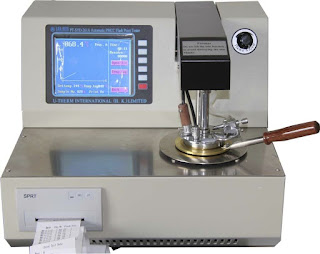ChemicalFormulas - This flash point and fire point test method is a dynamic method and depends on definite rates of temperature increases to control the precision of the test method. Its primary use is for viscous materials having flash point of 79°C (175°F) and above. It is also used to determine fire point, which is a temperature above the flash point, at which the test specimen will support combustion for a minimum of 5 s. Do not confuse this test method with Test Method D 4206, which is a sustained burning test, open cup type, at a specific temperature of 49°C (120°F).
Flash point values are a function of the apparatus design, the condition of the apparatus used, and the operational procedure carried out. Flash point can therefore only be defined in terms of a standard test method, and no general valid correlation can be guaranteed between results obtained by different test methods, or with test apparatus different from that specified.
Scope Of The Standar Test Method
1.1 This test method describes the determination of the flash point and fire point of petroleum products by a manual Cleveland open cup apparatus or an automated Cleveland open cup apparatus.
NOTE 1—The precisions for fire point were not determined in the current interlaboratory program. Fire point is a parameter that is not commonly specified, although in some cases, knowledge of this flammability temperature may be desired.
1.2 This test method is applicable to all petroleum products with flash points above 79°C (175°F) and below 400°C (752°F) except fuel oils.
NOTE 2—This test method may occasionally be specified for the determination of the fire point of a fuel oil. For the determination of the flash points of fuel oils, use Test Method D93. Test Method D93 should also be used when it is desired to determine the possible presence of small, but significant, concentrations of lower flash point substances that may escape detection by Test Method D 92. Test Method D 1310 can be employed if the flash point is known to be below 79°C (175°F).
1.3 The values stated in SI units are to be regarded as the standard. The values given in parentheses are for information only.
Terminology in standard test for Flash Fire Points in petroleum product
Dynamic in petroleum products is the condition where the vapor above the test specimen and the test specimen are not in temperature equilibrium at the time that the ignition source is applied. This is primarily caused by the heating of the test specimen at the constant prescribed rate with the vapor temperature lagging behind the test specimen temperature.
Fire point in petroleum products is the lowest temperature corrected to a barometric pressure of 101.3 kPa (760 mm Hg), at which application of an ignition source causes the vapors of a test specimen of the sample to ignite and sustain burning for a minimum of 5 s under specified conditions of test.
Flash point in petroleum products is the lowest temperature corrected to a barometric pressure of 101.3 kPa (760 mm Hg), at which application of an ignition source causes the vapors of a specimen of the sample to ignite under specified conditions of test.
The test specimen is deemed to have flashed when a flame appears and instantaneously propagates itself over the entire surface of the test specimen. When the ignition source is a test flame, the application of the test flame can cause a blue halo or an enlarged flame prior to the actual flash point. This is not a flash point and shall be ignored.





Thanks for sharing this informative post. It's very helpful. Keep it up!
ReplyDeleteFlammability Testing Equipment | Laboratory Testing Equipment & Instruments